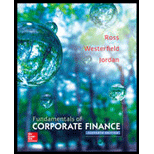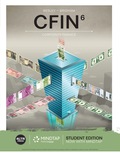
To determine: Whether the cash can be paid today or at the end of 3 years and the best alternative which generates a high after-tax income for the shareholders.
Introduction:
Dividends and reinvestments: The Company has 3 millions extra cash either reinvested or used for dividend payments. Extra cash can be used as dividends for the shareholders or it can be a reinvestment made in any financial asset.
Answer to Problem 15QP
Explanation of Solution
Given information:
When the company has 3 millions in extra cash, it opts for two alternatives:
- One is to pay dividends at the end of the three years to the shareholders
- Another is to reinvest in financial assets’ treasury bills or preferred stock
The firm can reinvest in T bills yielding 3% or 5% in the preferred stock and as per IRS regulations, the company can exclude a taxable income of 70% of the dividend received from investing in tax of another company.
The reinvesting income will pay a special dividend at the end of 3 years.
The
Formula:
The formula to calculate the after-tax cash flow:
The formula to calculate the
The formula to calculate the future value of treasury bills:
Note: n is the number of years; and since the company has $3 million after-tax, the full amount can be reinvested.
The reinvestment can opt for 2 alternatives:
- Investing in treasury bills and paying a special dividend at the end of 3 years.
- Another alternative is to pay the dividends today to the individuals and to invest on their own in the treasury bills or preferred stocks
Alternative: 1
The investment in treasury bills
Compute the after-tax of t-bills:
Hence, the after-tax of T-bill is 1.95%.
Compute the future value of investing in Treasury bill:
Hence, the future value of investment in T-bills is $3,178,944.
Compute the after-tax cash flow:
Note: These future values of investments will be paid to the shareholders as dividends.
The after-tax cash flow is as follows:
Hence, the after-tax cash flow is $2,702,102.82.
The investment in preferred stocks
In the case of preferred stocks, the dividends received will be again reinvested in the same preferred stocks and 70% of the incomes are excluded from tax.
Compute the dividend from the preferred stocks and taxable preferred dividend:
Hence, the preferred dividend is $150,000 and taxable preferred dividend is $45,000.
Compute the taxes, which the company pays:
Hence, the company pays $15,750 as taxes on the preferred stocks dividends.
Compute the after-tax corporate dividend and the after-tax dividend yield for the corporation:
Hence, the after-tax dividend yield is $134,250.
Hence, the after-tax corporate dividend yield is 4.475%.
Compute the future value of investing in the preferred stock:
Hence, the future value of the investment of the preferred stock is $3,421,041.
Compute the after-tax cash flow:
Note: These future values of investments will be paid to the shareholders as dividend.
The after-tax cash flow is as follows:
Hence, the after- tax cash flow of the shareholders is $2,907,886.
Alternative: 2
Another alternative is to pay the dividends today to the individuals and to invest on their own in the treasury bills or preferred stocks.
The individual investment in treasury bills:
Compute the after-tax cash received today by the shareholders:
Hence, the after-tax received today by the shareholders is $2,550,000.
If this cash is invested in the Treasury bill, the yield will be as follows:
Compute the after-tax individual yield on T-bills:
Hence, the after-tax individual yield is 2.07%.
Compute future value of individual investment in T-bills:
Hence, the future value of individual investment in T-bills is $2,711,655.57.
The individual investment in preferred stocks
When the individual invests in preferred stocks, the dividend earned from these stocks will be reinvested in the same stocks.
Compute the dividend earned from the preferred stocks:
Hence, the dividend earned from the preferred stocks is $127,500.
Compute the taxes, which the individual pays on preferred stocks:
Hence, the taxes on the preferred dividend are $15,750.
Compute the individual after-tax preferred dividend and yield on the after-tax preferred dividend:
Hence, the after-tax preferred dividend is $87,975 and the after-tax preferred dividend yield is 3.52%.
Compute the future value of the individual investment in the preferred stock:
Hence, the future value of the individual investment in the preferred stock is $2,823,135.
The best alternative, which generates the highest after-tax income for the shareholders:
Alternative: 1
Investment in treasury bills:
The after-tax cash flow to the shareholders is $2,702,102.82.
Investment in preferred stocks
The after-tax cash flow to the shareholders is $2,907,886.
The alternative: 1 with preferred stock: Investing the cash in the preferred stock gives the maximized after-tax cash flow to the shareholders which can be paid as a special dividend at the end of three years.
Thus, the dividends can be paid at the end of 3 years and the best alternative to invest the cash is in preferred stocks.
Want to see more full solutions like this?
Chapter 17 Solutions
Fundamentals of Corporate Finance
 EBK CONTEMPORARY FINANCIAL MANAGEMENTFinanceISBN:9781337514835Author:MOYERPublisher:CENGAGE LEARNING - CONSIGNMENT
EBK CONTEMPORARY FINANCIAL MANAGEMENTFinanceISBN:9781337514835Author:MOYERPublisher:CENGAGE LEARNING - CONSIGNMENT Intermediate Financial Management (MindTap Course...FinanceISBN:9781337395083Author:Eugene F. Brigham, Phillip R. DavesPublisher:Cengage Learning
Intermediate Financial Management (MindTap Course...FinanceISBN:9781337395083Author:Eugene F. Brigham, Phillip R. DavesPublisher:Cengage Learning




